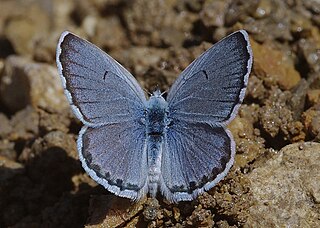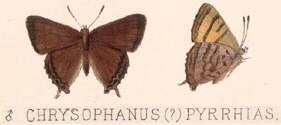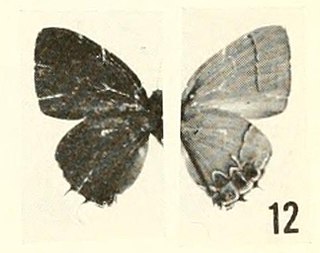
Lycaenidae is the second-largest family of butterflies, with over 6,000 species worldwide, whose members are also called gossamer-winged butterflies. They constitute about 30% of the known butterfly species.

Riodinidae is the family of metalmark butterflies. The common name "metalmarks" refers to the small, metallic-looking spots commonly found on their wings. The 1532 species are placed in 146 genera. Although mostly Neotropical in distribution, the family is also represented both in the Nearctic and the Palearctic.

Cyclargus is a genus of butterflies in the family Lycaenidae. It was split off from the genus Hemiargus in 1948 by Vladimir Nabokov, although many lepidopterists have not accepted the new genus as valid. Nabokov designated C. ammon as the type species for the genus, and included C. dominica, C. thomasi, C. woodruffi and C. erembis. In 1992 K. Johnston and Matusik described C. sorpresus and C. kathleena, both from Hispaniola.

Miletinae is a subfamily of the family Lycaenidae of butterflies, commonly called harvesters and woolly legs, and virtually unique among butterflies in having predatory larvae. Miletinae are entirely aphytophagous. The ecology of the Miletinae is little understood, but adults and larvae live in association with ants, and most known species feed on Hemiptera, though some, like Liphyra, feed on the ants themselves. The butterflies, ants, and hemipterans, in some cases, seem to have complex symbiotic relationships benefiting all.

Pseudophilotes vicrama, the eastern baton blue, is a small butterfly found from Asia, east to Tian Shan and parts of China, west to the Balkans, Turkey, eastern Europe to southern Finland. It belongs to the lycaenids or blues family.

The scarce large blue is a species of butterfly in the family Lycaenidae. It is found in Austria, Slovenia, Croatia, the Czech Republic, France, Georgia, Germany, Hungary, Italy, Japan, Kazakhstan, Mongolia, the Netherlands, Poland, Romania, Russia, northern Serbia, Spain, Switzerland, and Ukraine and East across the Palearctic to Japan. The species was first described by Johann Andreas Benignus Bergsträsser in 1779.

Electrostrymon is a genus of Neotropical butterflies in the family Lycaenidae.

Iophanus is a monotypic butterfly genus in the family Lycaenidae described by Max Wilhelm Karl Draudt in 1920. The single species of this genus, Iophanus pyrrhias, the Guatemalan copper, was described by Frederick DuCane Godman and Osbert Salvin in 1887. It is found in Guatemala, the highlands of Chiapas, Mexico, and apparently in a few other areas of the Neotropical realm.

Zizeeria knysna, the dark grass blue or African grass blue, is a species of blue butterfly (Lycaenidae) found in Africa, on Cyprus and the Iberian Peninsula.

Tajuria is an Indomalayan genus of butterflies in the family Lycaenidae.

Cupido is a genus of butterflies in the family Lycaenidae. The subgenus Everes is included here.

Paul Dognin was a French entomologist who specialised in the Lepidoptera of South America. Dognin named 101 new genera of moths.

Hemiargus ceraunus, the Ceraunus blue, is a butterfly in the family Lycaenidae. The species was first described by Johan Christian Fabricius in 1793. It is found in the southwestern United States, southern Texas, Florida and the Florida Keys south through the West Indies, Mexico and Central America to South America. Strays may be found in North Carolina, Missouri, Kansas and Nevada. The habitat consists of open woodland, desert scrub, dunes, pastures, road edges and vacant lots.

Hemiargus hanno, the hanno blue is a butterfly in the family Lycaenidae. It is found in Suriname, Brazil, Colombia and on Cuba, the Netherlands Antilles, Puerto Rico and Hispaniola.

Electrostrymon joya, the muted hairstreak, is a butterfly of the family Lycaenidae. It was described by Paul Dognin in 1895. It is found from southern Texas and Mexico to Ecuador, Peru and Tobago, as well as on the Netherlands Antilles. The habitat consists of openings and edges in tropical semideciduous river forests and second growth.

Calycopis pisis, the pisis groundstreak, is a butterfly found in several countries in Latin America.
Ipidecla schausi, also called Schaus' hairstreak or Salvin's dwarf, is a small butterfly in the family Lycaenidae, sub-family Theclinae and genus Ipidecla.
















